Overhanging Rattly Finger Cracks
Hey Steph,
First off just want to say that I love following your blog and admire how you live your life!
I was wondering if you had any advice for me. There is a finger crack in my climbing gym that I have been working on for a while. The bottom portion is completely vertical and I’m at a point now where I feel confident on it. However, the top part is slightly overhung. Everytime I make my first ring-lock on the increased incline I feel like I have no idea how I will get my next one in. I have struggled through it a few times but I would love to hear any tips you have to give!
Thanks!
Kristin G
Hi Kristin,
Overhanging ringlocks are the nastiest thing ever. First, make sure you have the right tools:
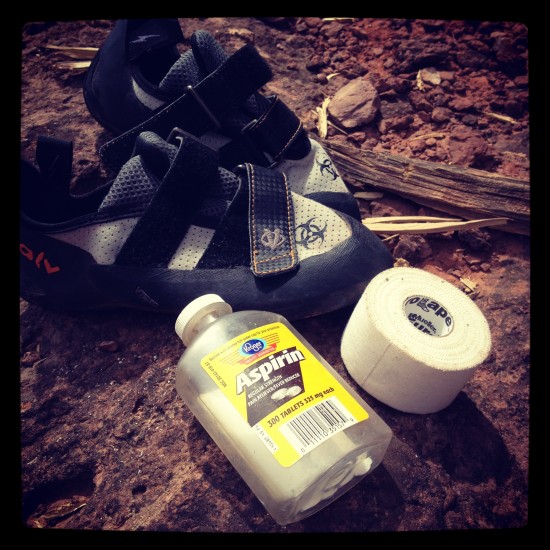
Mueller Eurotape is stickier than other cloth tapes, and this is super important. You can buy it, even by phone, from Gearheads in Moab. I take two aspirin when starting my hike up to a hard rattly finger crack, and then take another one or two as needed between burns. This makes a huge difference. Caffeine is also a natural pain killer, so coffee or those caffeinated Clif shot blocks are a good add-on. (Just be careful you don’t get all jangly).
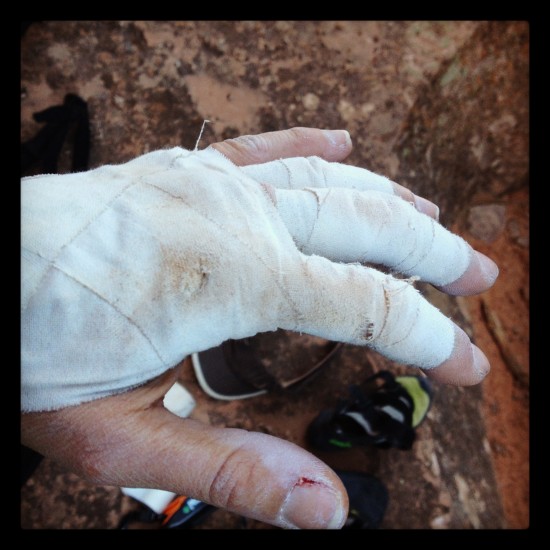
When taping for ringlocks, you need to do full handtape, because this is how you can keep the tape from rolling up your fingers and becoming worthless. You are trying to protect that goby spot where your index finger is above your hand, and also that knuckle where finger meets hand. If you don’t tape, you will immediately rip a hole in your skin. If you tape wrong, it will roll and just make it harder to do the jams. My trick is to tape the index finger before adding the hand tape. With my hand taping method, there is a strap of tape that goes around the index finger. Make sure that tape strap is covering and holding down the end of your index finger tape wrap, and this will keep it from rolling up. Like I said, I do an entire hand tape job even if the route has no hand size on it, solely to keep that index finger tape from rolling.
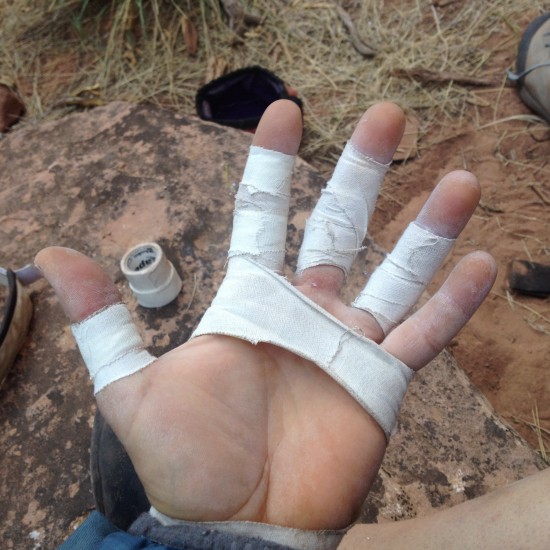
You want to tape the index finger and the next finger, because they are getting most of the pressure inside the crack. Your index finger joint and your index and middle finger knuckles will rub and get gobed otherwise. You also want to tape your ring finger, because this finger will be getting pressed against the sharp, opposite edge of the crack, and can be cut by the edge. Your pinky is worthless to you in ringlocks, and doesn’t need taping. You also might want to add a tape wrap around your thumb, because the thumb is getting pressed against an edge also and can get cut. Above all, do not get cut, because then you will have to wait for your skin to grow and you will have to deal with even more pain if you don’t want to quit trying. If you are working on ringlocks, and your tape rolls or wears through, hang or come down to fix your tape. I usually thread a roll of finger tape onto a quickdraw when I’m working a rattly fingercrack, because if I’m having a tape blow-out, I can just hang and re-tape. Once your skin goes, everything is bad, so don’t get all stubborn and climb to the point of gobing. Unless maybe you are on a send effort.
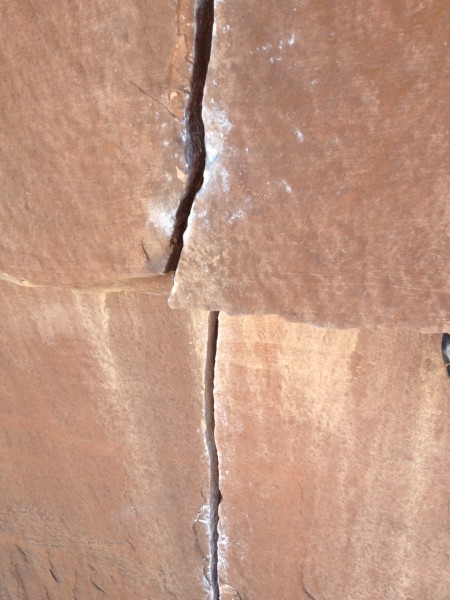
Now find an overhanging rattly finger crack…
There are basically two situations between good fingers and tight hands. For me, this is the full nasty range between orange metolius and red metolius, which includes purple camalots and tight green camalots. There is your classic rattly fingers (orange metolius and purple camalot for me) and the bigger ratchet size (red metolius and tight green camalot for me). They both have their own special nastiness. But as always, the most important thing is feet, even when overhanging. Use your normal, ankle-torque crack foot technique, and get as much purchase as possible on your feet.
 If you can find any small pods, offset sections or flares, those will be the best feet. If not, try to keep your feet high, and torque as much as possible. The shoe rubber will give you something.
If you can find any small pods, offset sections or flares, those will be the best feet. If not, try to keep your feet high, and torque as much as possible. The shoe rubber will give you something.
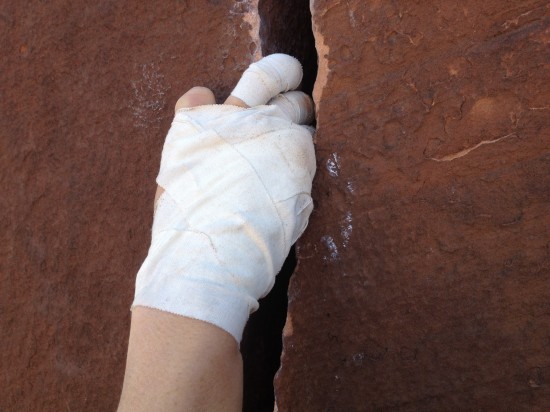
With your hands, stick your fingers in except for your pinky (sometimes I even curl it down to make sure it’s not in the way), and twist like hell. Pull your elbow down all the way, toward your stomach. Inside the crack, curl your fingers as hard as you can, which is really pumpy and strenuous. The more you can curl your fingers, the more the ringlock will actually stick. The thing about vertical ringlocks is that to a certain extent you can get away with technique and good crack feet. When it’s overhung, you need all the technique, but you have to add a lot of force. The best way to train for steep ringlocks is to climb them again and again until it starts working. This is where aspirin is key. Like slopers, ringlocks need to be nose-height or higher to stick.
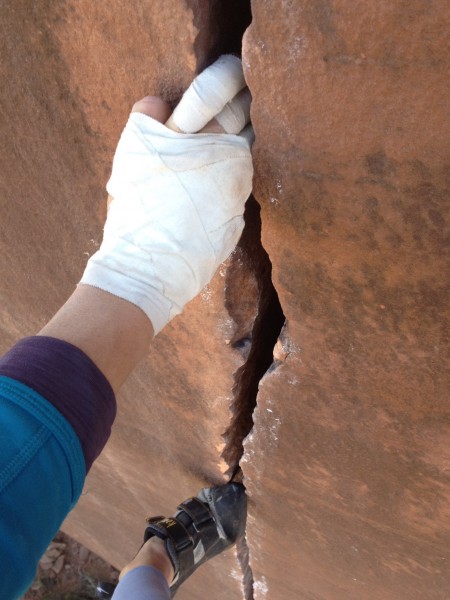
When you get into the ratchet size, things get slightly weird because it almost seems like you could force a super tight wannabe hand jam in, which is obviously tempting in theory. Usually that doesn’t end up working, especially when you are pumped. Usually the best thing is to accept the ratchets.
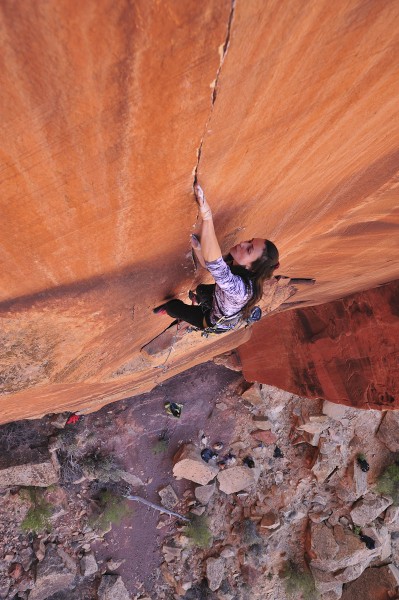
Recently I’ve noticed that if I make a point of pressing the tip of my thumb hard against the inside of the crack (on the opposite side from where your index finger is pushing against the outside edge), I get a lot more power from the ratchets, and they are much more solid. With ratchets, at least the crack is a little bit wider for the feet, and I usually try to keep my feet extra high, because for some reason that seems to work better.
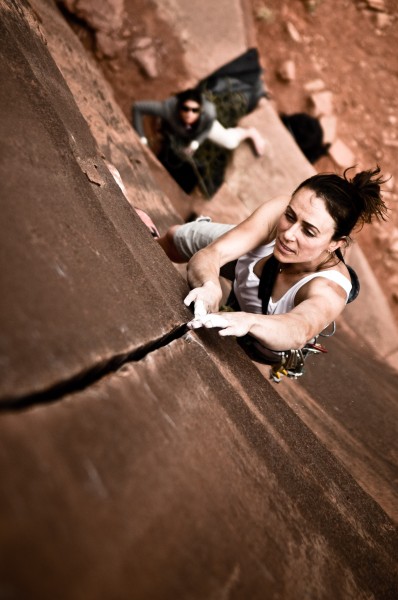
The great thing about rattly finger size is that your worst nemesis will always be someone else’s easiest size, and vice versa. For example, most of the gorgeous, iconic desert testpieces seem to be the purple camalot size, which is good fingers for most guys, and hideous rattly fingers for me. Working at it and climbing them anyway has made me a much better crack climber, and is incredibly satisfying (dare I say empowering?). By training and applying yourself to your worst possible crack sizes, you will no longer be shut down by the nasty sizes, and you will be able to dominate the world ;D
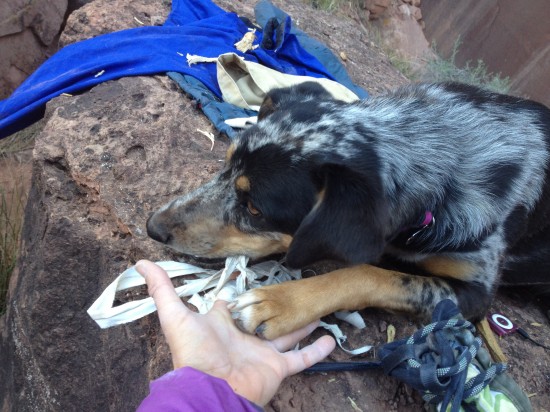
Try to remember to put a pair of scissors in your pack, because after you are done abusing yourself in the crack, it can get really hard to get the tape off. Puppy teeth work well too, and always make you feel better after a good rattly finger spanking.








love the dog shots
thanks 🙂
Steph… your blog and your compassion are awesome!
Hi Steph, I’d ask “how have you been” but after seeing photos, videos, and blog posts, it looks like you’re doing great. Congrats on your fun/exciting life. Mike
Hello Steph, here you have a faithful follower of your blog as much of your FB, I would like to one day have the opportunity to meet you in person if I return to the United States, your photos of climbing and base jumping are great, nice to see you doing everything you do, congratulations from Barcelona Spain
thanks Jorge 🙂
Nice post–lot’s of good info–any similar beta for tight fingers? Not tips….my fear is ripping my fingers off my hand if I fall!
🙂 I am always thinking that too, but so far if I’ve fallen out of tight fingers, it didn’t happen…
Hey Steph. Thanks for the advice…I finally sent it! It was my hardest grade I have ever lead at a 5.12+. Your blog always gives me incentive to climb harder. You definitely empower me as a female climber! Thank you for being such an inspirational role model.
cheers ! 🙂
goodluck
Mueller Eurotape is also sold at Vertical World in Redmond, WA for those PNW crack climbers. I find it to be much better for climbing than the regular tape. Thanks for your advice Steph.
It is much sticker 🙂 Glad you guys can get it in the northwest too!
Steph
Great resource that keeps coming up on searches. Climbed for 15 years mostly in Yosemite and Jtree- hurt and 4 years off. Now trying to use better technique because my shoulder only allows limited climbing. Starting to go to Indian Creek more.
First time I have seen to leave the pinky out of those jams on purpose. I am starting to work on this size. Can you explain how leaving the pinky out helps?
I think it gives you more contact surface because the side of your ring finger is bigger than the side of your pinky…but as with all these techniques, it’s not gospel for every crack. Definitely on some, I find it feels more solid.
Thanks for taking the time to share some tips Steph! I can’t wait to get in a painful crack and soil my harness!